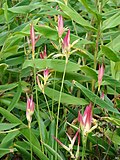List Of Commelinid Families
The commelinids are a group of 29 interrelated families of flowering plants, named for one of the four included orders, Commelinales. This subgroup of the monocots accounts for most of the global agricultural output; the grass family alone contains the major cereal grains (including rice, wheat, and maize or corn), along with forage grasses, sugar cane, and bamboo. The palm, banana, ginger, pineapple and sedge families are also commelinids.
Traits common to most commelinids include partially fluorescent cell walls, starchy seeds and an extra layer of epidermal wax. Like other monocots, they usually have a single embryonic leaf (cotyledon) in their seeds, scattered vascular systems, leaves with parallel veins, flowers with parts in threes or multiples of three, and roots that can develop in more than one place along the stems. These plants are found worldwide, even in mainland Antarctica; two species of grass are the only vascular plants found there.
Glossary
From the glossary of botanical terms:
- annual: a plant species that completes its life cycle within a single year or growing season
- basal: attached close to the base (of a plant or an evolutionary tree diagram)
- climber: a vine that leans on, twines around or clings to other plants for vertical support
- herbaceous: not woody; usually green and soft in texture
- perennial: not an annual or biennial
- woody: hard and lignified; not herbaceous
The APG IV system is the fourth in a series of plant taxonomies from the Angiosperm Phylogeny Group.
Families
| Family and a common name | Type genus and etymology | Total genera; global distribution | Description and uses | Order | Type genus images |
|---|---|---|---|---|---|
| Arecaceae (palm family) |
Areca was named for a Malabar plant. | 180 genera, in the tropics, the subtropics, and some temperate regions | This family includes trees, shrubs, shrublets and climbers. Leaves are often sharp and prickly. The coco-de-mer has the heaviest seed of any plant, at up to 30 kilograms (66 lb), and Corypha umbraculifera has the largest inflorescence, with up to 10 million flowers. One 2000-year-old date palm seed has been germinated successfully. | Arecales | Areca catechu  |
| Bromeliaceae (pineapple family) |
Bromelia was named for Olof Bromelius (1639–1705), a Swedish doctor and botanist. | 76 genera, widespread in the tropical and warm temperate Americas | These plants mostly grow on other plants or rocks. Leaves can be multihued, and are usually long and rigid. Spanish moss was formerly an important packing material in the southern United States. Puya chilensis is sometimes considered carnivorous, by virtue of its sharp-tipped leaves. | Poales | Bromelia pinguin  |
| Cannaceae (canna-lily family) |
Canna comes from a Greek plant name. | 1 genus, in the tropics and subtropics of the Americas | These non-woody plants are tall, with many broad leaves. They are bred by horticulturists and cultivated around the world. Rhizomes of Canna discolor are a staple food in parts of Asia. | Zingiberales | Canna indica  |
| Commelinaceae (spiderwort family) |
Commelina was named for Jan (1629–1692) and Caspar Commelijn (1667–1734). | 36 genera, throughout the tropics, and in parts of East Asia and temperate North America | These fleshy plants are non-woody perennials and annuals. Commelina communis is sometimes consumed in Asia. | Commelinales | Commelina communis 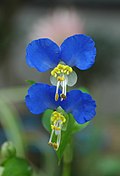  |
| Costaceae (spiral-ginger family) |
Costus comes from a Latin plant name. | 8 genera, throughout the tropics | These plants are usually large perennials with showy bracts. Unlike the plants in the ginger family, these are not aromatic. Dimerocostus fruit is consumed in South America. | Zingiberales | Costus pictus   |
| Cyperaceae (sedge family) |
Cyperus comes from a Greek plant name. | 94 genera, worldwide | These non-woody plants grow in soil and water. Annual species generally grow in bunches, like tufts of grass. Papyrus is still used as a paper substitute, and edible tubers of Cyperus esculentus are still cultivated, both probably since 3000 BC. Papyrus is widely considered an invasive species. Totora reeds are occasionally woven into rafts. | Poales | Cyperus esculentus  |
| Dasypogonaceae (savior-grass family) |
Dasypogon is from the Greek for "hairy beard". | 4 genera, in Australia | These perennials can be shrubby or tree-shaped, with wide or grassy leaves. One genus, Baxteria, has a putrified smell, perhaps to facilitate pollination. | Arecales | Dasypogon bromeliifolius  |
| Ecdeiocoleaceae (kwongan-rush family) |
Ecdeiocolea is from the Greek for "binding sheath". | 2 genera, in Western Australia | These non-woody perennials grow in tufts, similar to clumps of rushes. Leaves are little more than sheaths. | Poales | Ecdeiocolea monostachya  |
| Eriocaulaceae (pipewort family) |
Eriocaulon is from the Greek for "woolly stem". | 7 genera, across the tropics, extending into some temperate zones worldwide | These plants are non-woody, sometimes aquatic annuals and perennials, and usually tufted. One species, Syngonanthus nitens, is used in handicrafts. | Poales | Eriocaulon decangulare  |
| Flagellariaceae (whip-vine family) |
Flagellaria is from the same root as flagelliform, "whip-like". | 1 genus, in tropical and southern Africa, Southeast Asia, and Oceania | These non-woody rhizomatous perennials have leaves with tendrils or tendril-shaped tips. The plants are used in basket-weaving. | Poales | Flagellaria indica  |
| Haemodoraceae (kangaroo-paw family) |
Haemodorum is from the Greek for "blood gift". | 15 genera, in Australia, South Africa, and the Americas | These non-woody perennials have rhizomes, bulbs or other underground organs, usually reddish or orangish. Roots of Haemodorum produce a potable red pigment. | Commelinales | Haemodorum corymbosum 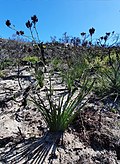 |
| Hanguanaceae (susum family) |
Hanguana was named for an Indonesian plant. | 1 genus, in Sri Lanka, Southeast Asia and Oceania | These non-woody perennials are found in humid forests and waterways. Stems of Hanguana anthelminthica are edible. | Commelinales | Hanguana malayana  |
| Heliconiaceae (parrot-flower family) |
Heliconia comes from a Latin plant name (an apparent reference to Mount Helicon). | 1 genus, in the tropical Americas and Oceania | These are large non-woody evergreens with crested multihued bracts. The inflorescences are bred by horticulturists. | Zingiberales | Heliconia psittacorum |
| Joinvilleaceae (ohe family) |
Joinvillea was named for François d'Orléans, Prince of Joinville (1818–1900). | 1 genus, in Southeast Asia and Pacific islands | These large, non-woody rhizomatous plants are similar to whip vine. Stems are hollow, except at the nodes. | Poales | Joinvillea ascendens  |
| Juncaceae (rush family) |
Juncus was the Classical Latin name for this plant, from the Latin for "binding". | 8 genera, worldwide, except for most of the Amazon basin | These non-woody, usually rhizomatous plants are similar to the grass and sedge families, with adaptations to wind-pollination. They are used for fodder and in woven goods; in the Andes, they are also used as fuel. | Poales | Juncus acutus  |
| Lowiaceae (orchid-lily family) |
Lowia, an earlier synonym for Orchidantha, was named for Hugh Lowe (1824–1905), an English colonial administrator and naturalist. | 1 genus, in tropical Asia | These smooth, non-woody plants are generally found near streams in evergreen forests. | Zingiberales | Orchidantha fimbriata  |
| Marantaceae (prayer-plant family) |
Maranta was named for Bartolomeo Maranta (1500–1571). | 29 genera, throughout the tropics, and extending a bit north and south in the Americas | These are non-woody forest-dwelling or aquatic plants, some with bamboo-like stems. The Caribbean species arrowroot is cultivated for its edible starch. | Zingiberales | Maranta arundinacea  |
| Mayacaceae (bog-moss family) |
Mayaca was named for a French Guianese plant. | 1 genus, in the tropics of the Americas | These aquatic, largely nonvascular plants resemble clubmosses. They are mostly submerged, except for the flowers and bracts. | Poales | Mayaca fluviatilis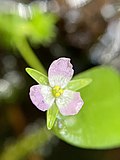  |
| Musaceae (banana family) |
Musa is generally believed to come from the Arabic word for this plant, although Linnaeus gave a different origin. | 3 genera, native to the Old-World tropics, and cultivated in the tropics worldwide | These very large non-woody plants have heavy leaves that are frequently torn by the wind. Bananas have been cultivated and bred for thousands of years, and are a staple food crop throughout the tropics. Musa ingens, growing over 15 metres (49 ft) tall and up to 2 metres (6 ft 7 in) in circumference, is the largest non-woody plant in the world. | Zingiberales | Musa acuminata  |
| Philydraceae (frogsmouth family) |
Philydrum is from the Greek for "friend of water". | 3 genera, in Southeast Asia, Oceania and parts of Japan | These non-woody perennials have rhizomes and other underground organs. | Commelinales | Philydrum lanuginosum  |
| Poaceae (grass family) |
Poa comes from a Greek plant name. | 793 genera, worldwide | These plants generally have adaptations that protect them from grazing animals, including a network of underground rhizomes and narrow leaves that grow from their base. This big family includes rice, wheat, maize or corn, most forage grasses, sugar cane, bamboo, and many other economically important plants. Bamboo stalks have been known to grow more than 2 meters (6 ft 7 in) per day. The global appearance of grasslands around 33 million years ago reduced atmospheric carbon dioxide over time and cooled the planet, largely thanks to C4 photosynthesis, which is efficient in hot climates. | Poales | Poa pratensis 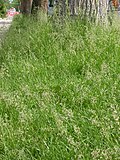 |
| Pontederiaceae (water hyacinth family) |
Pontederia was named for Giulio Pontedera (1688–1757). | 2 genera, throughout the tropics and in parts of North America | This non-woody aquatic plant family includes submerged, floating, and emergent species, some with rhizomes. Pontederia crassipes is used for fodder, fertilizer, biofuel and water treatment, but it has become invasive in warmer climates worldwide. | Commelinales | Pontederia cordata  |
| Rapateaceae (tow-tow family) |
Rapatea was probably named for a French Guianese plant. | 17 genera, mostly in tropical South America and along the West African coast | These rhizomatous non-woody perennials grow in soil, in water and on trees or other plants. | Poales | Rapatea paludosa  |
| Restionaceae (fynbos family) |
Restio comes from the Latin for "rope-maker". | 48 genera, in southern Africa, Madagascar, Southeast Asia, South America and Oceania | These evergreen perennials are similar to rushes, with adaptations to wind-pollination. Leaves are usually just sheaths; green stems provide photosynthesis. Thamnochortus insignis is used for roofing in South Africa. Female Alexgeorgea flowers in Australia grow mostly underground, except for their tips. | Poales | Restio festuciformis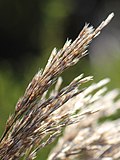  |
| Strelitziaceae (traveller's-palm family) |
Strelitzia was named for Charlotte of Mecklenburg-Strelitz (1744–1818), the wife of George III. | 3 genera, in the tropics of South America; parts of South Africa and Madagascar | These non-woody evergreen perennials can be shrubby or almost tree-shaped. The bare, unbranched flower stalks of Phenakospermum can reach almost 4 metres (13 ft). Bird-of-paradise plants, Strelitzia reginae, are sold in the cut-flower market. Queen Charlotte was a supporter of the gardens at Kew, which later became the Royal Botanic Gardens. | Zingiberales | Strelitzia reginae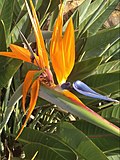  |
| Thurniaceae (palmiet family) |
Thurnia was named for Everard im Thurn (1852–1932). | 2 genera, in northern South America and South Africa | These non-woody perennials are rhizomatous. | Poales | Thurnia sphaerocephala  |
| Typhaceae (bulrush family) |
Typha comes from a Greek plant name. | 2 genera, worldwide | These wetlands perennials are amphibious, with starchy rhizomes. The family is adapted to wind-pollination. Previously a food source, the plants are sometimes used today for water treatment. | Poales | Typha latifolia  |
| Xyridaceae (yellow-eyed-grass family) |
Xyris is from the Greek for "razor". | 5 genera, in the tropics worldwide, temperate Australia and eastern North America | These non-woody rhizomatous plants often grow in wetlands. | Poales | Xyris gracilis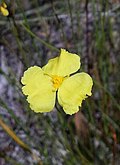 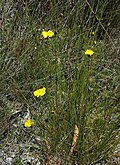 |
| Zingiberaceae (ginger family) |
Zingiber comes from Greek and possibly Sanskrit plant names. | 57 genera, throughout the tropics, with some as far north as Japan and as far south as the Himalayas and South Africa | These plants are non-woody perennials, oily and fragrant or strong-smelling, some with large, showy bracts. Ginger was used as a spice in ancient India and Rome, and is still in wide use as a spice and condiment. Turmeric has been grown in India for millennia. | Zingiberales | Zingiber officinale (ginger)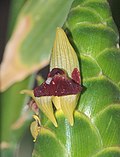  |
See also
Notes
- ^ The taxonomy (classification) in this list follows Plants of the World (2017) and the fourth Angiosperm Phylogeny Group system. Total counts of genera for each family come from Plants of the World Online. (See the POWO license.) Extinct taxa are not included. The commelinids form a clade, that is, a subgroup consisting of all the descendants of a theoretical ancient ancestor.
- ^ Each family's formal name ends in the Latin suffix -aceae and is derived from the name of a genus that is or once was part of the family.
- ^ Some plants were named for naturalists (unless otherwise noted).
- ^ See Photosynthesis § C3 : C4 photosynthesis research for the chemistry of C4 photosynthesis.
Citations
- ^ Christenhusz, Fay & Chase 2017.
- ^ Angiosperm Phylogeny Group 2016.
- ^ POWO.
- ^ Christenhusz, Fay & Chase 2017, pp. 10, 642.
- ^ Givnish et al. 2010, p. 585.
- ^ Royal Botanic Gardens.
- ^ Christenhusz, Fay & Chase 2017, pp. 175–211.
- ^ Christenhusz, Fay & Chase 2017, pp. 115–116.
- ^ Christenhusz, Fay & Chase 2017, pp. 175, 206–211.
- ^ Christenhusz, Fay & Chase 2017, pp. 638–670.
- ^ ICN, art. 18.
- ^ Stevens 2023, Summary of APG IV.
- ^ Stearn 2002, p. 49.
- ^ IPNI, Arecaceae, Type Name.
- ^ Christenhusz, Fay & Chase 2017, pp. 177–179.
- ^ POWO, Arecaceae.
- ^ POWO, Arecaceae, Flora of Tropical East Africa.
- ^ POWO, Arecaceae, Flora of West Tropical Africa.
- ^ Christenhusz, Fay & Chase 2017, pp. 194–196.
- ^ IPNI, Bromeliaceae, Type Name.
- ^ Smith & Till 1998, p. 82.
- ^ POWO, Bromeliaceae.
- ^ POWO, Bromeliaceae, Flora of West Tropical Africa.
- ^ Coombes 2012, p. 80.
- ^ Christenhusz, Fay & Chase 2017, p. 188.
- ^ POWO, Cannaceae.
- ^ POWO, Cannaceae, Flora of West Tropical Africa.
- ^ POWO, Cannaceae, Flora of Somalia.
- ^ Coombes 2012, p. 101.
- ^ IPNI, Commelinaceae, Type Name.
- ^ Christenhusz, Fay & Chase 2017, pp. 180–181.
- ^ POWO, Commelinaceae.
- ^ POWO, Commelinaceae, Neotropikey.
- ^ Stearn 2002, p. 105.
- ^ IPNI, Costaceae, Type Name.
- ^ Christenhusz, Fay & Chase 2017, pp. 190–191.
- ^ POWO, Costaceae.
- ^ POWO, Costaceae, Neotropikey.
- ^ Coombes 2012, p. 115.
- ^ IPNI, Cyperaceae, Type Name.
- ^ Christenhusz, Fay & Chase 2017, p. 200.
- ^ POWO, Cyperaceae.
- ^ POWO, Cyperaceae, Neotropikey.
- ^ Christenhusz, Fay & Chase 2017, p. 175.
- ^ USDA, Dasypogon, id=344.
- ^ POWO, Dasypogonaceae.
- ^ Christenhusz, Fay & Chase 2017, pp. 205–206.
- ^ USDA, Ecdeiocolea.
- ^ POWO, Ecdeiocoleaceae.
- ^ Christenhusz, Fay & Chase 2017, p. 198.
- ^ IPNI, Eriocaulaceae, Type Name.
- ^ POWO, Eriocaulaceae.
- ^ POWO, Eriocaulaceae, Flora of Tropical East Africa.
- ^ Christenhusz, Fay & Chase 2017, p. 204.
- ^ POWO, Flagellariaceae.
- ^ POWO, Flagellariaceae, Flora of Tropical East Africa.
- ^ Christenhusz, Fay & Chase 2017, pp. 183–184.
- ^ IPNI, Haemodoraceae, Type Name.
- ^ POWO, Haemodoraceae.
- ^ POWO, Haemodoraceae, Neotropikey.
- ^ Christenhusz, Fay & Chase 2017, pp. 179–180.
- ^ POWO, Hanguanaceae.
- ^ Stearn 2002, p. 162.
- ^ Christenhusz, Fay & Chase 2017, p. 186.
- ^ POWO, Heliconiaceae.
- ^ POWO, Heliconiaceae, Neotropikey.
- ^ Burkhardt 2018, Joinvillea.
- ^ Christenhusz, Fay & Chase 2017, pp. 204–205.
- ^ POWO, Joinvilleaceae.
- ^ Coombes 2012, p. 180.
- ^ IPNI, Juncaceae, Type Name.
- ^ POWO, Juncaceae.
- ^ POWO, Juncaceae, Flora of West Tropical Africa.
- ^ Burkhardt 2018, Lowia.
- ^ Christenhusz, Fay & Chase 2017, p. 185.
- ^ POWO, Lowiaceae.
- ^ Christenhusz, Fay & Chase 2017, pp. 189–190.
- ^ IPNI, Marantaceae, Type Name.
- ^ POWO, Marantaceae.
- ^ POWO, Marantaceae, Flora of West Tropical Africa.
- ^ Stearn 2002, p. 203.
- ^ Christenhusz, Fay & Chase 2017, p. 199.
- ^ POWO, Mayacaceae.
- ^ POWO, Mayacaceae, Neotropikey.
- ^ Stearn 2002, p. 212.
- ^ IPNI, Musaceae, Type Name.
- ^ Christenhusz, Fay & Chase 2017, pp. 187–188.
- ^ POWO, Musaceae.
- ^ POWO, Musaceae, Flora of West Tropical Africa.
- ^ Christenhusz, Fay & Chase 2017, pp. 181–182.
- ^ IPNI, Philydraceae, Type Name.
- ^ POWO, Philydraceae.
- ^ Coombes 2012, p. 238.
- ^ IPNI, Poeae (synonym), Type Name.
- ^ Christenhusz, Fay & Chase 2017, pp. 206–211.
- ^ POWO, Poaceae.
- ^ POWO, Poaceae, Flora of Tropical East Africa.
- ^ Christenhusz, Fay & Chase 2017, pp. 182–183.
- ^ IPNI, Pontederiaceae, Type Name.
- ^ POWO, Pontederiaceae.
- ^ POWO, Pontederiaceae, Flora of Tropical East Africa.
- ^ Christenhusz, Fay & Chase 2017, pp. 196–197.
- ^ IPNI, Rapateaceae, Type Name.
- ^ POWO, Rapateaceae.
- ^ POWO, Rapateaceae, Flora of West Tropical Africa.
- ^ Christenhusz, Fay & Chase 2017, pp. 202–204.
- ^ IPNI, Restionaceae, Type Name.
- ^ POWO, Restionaceae.
- ^ POWO, Restionaceae, Flora of Tropical East Africa.
- ^ Christenhusz, Fay & Chase 2017, pp. 184–185.
- ^ IPNI, Strelitziaceae, Type Name.
- ^ POWO, Strelitziaceae.
- ^ POWO, Strelitziaceae, Neotropikey.
- ^ Burkhardt 2018, Thurnia.
- ^ IPNI, Thurniaceae, Type Name.
- ^ Christenhusz, Fay & Chase 2017, pp. 199–200.
- ^ POWO, Thurniaceae.
- ^ POWO, Thurniaceae, Neotropikey.
- ^ Coombes 2012, p. 295.
- ^ IPNI, Typhaceae, Type Name.
- ^ Christenhusz, Fay & Chase 2017, pp. 193–194.
- ^ POWO, Typhaceae.
- ^ POWO, Typhaceae, Neotropikey.
- ^ Christenhusz, Fay & Chase 2017, pp. 197–198.
- ^ IPNI, Xyridaceae, Type Name.
- ^ POWO, Xyridaceae.
- ^ POWO, Xyridaceae, Flora of Tropical East Africa.
- ^ Christenhusz, Fay & Chase 2017, pp. 191–193.
- ^ Stearn 2002, p. 314.
- ^ POWO, Zingiberaceae.
- ^ POWO, Zingiberaceae, Flora of Tropical East Africa.
References
- Angiosperm Phylogeny Group (2016). "An update of the Angiosperm Phylogeny Group classification for the orders and families of flowering plants: APG IV". Botanical Journal of the Linnean Society. 181 (1): 1–20. doi:10.1111/boj.12385.
- Burkhardt, Lotte (2018). Verzeichnis eponymischer Pflanzennamen – Erweiterte Edition [Index of Eponymic Plant Names – Extended Edition] (pdf) (in German). Berlin: Botanic Garden and Botanical Museum, Freie Universität Berlin. doi:10.3372/epolist2018. ISBN 978-3-946292-26-5. S2CID 187926901. Retrieved January 1, 2021. See the licence.
- Christenhusz, Maarten; Fay, Michael Francis; Chase, Mark Wayne (2017). Plants of the World: An Illustrated Encyclopedia of Vascular Plants. Chicago, Illinois: Kew Publishing and The University of Chicago Press. ISBN 978-0-226-52292-0.
- Coombes, Allen (2012). The A to Z of Plant Names: A Quick Reference Guide to 4000 Garden Plants. Portland, Oregon: Timber Press. ISBN 978-1-60469-196-2.
- Givnish, Thomas J.; Ames, Mercedes; McNeal, Joel R.; McKain, Michael R.; Steele, P. Roxanne; dePamphilis, Claude W.; Graham, Sean W.; Pires, J. Chris; Stevenson, Dennis W.; Zomlefer, Wendy B.; Briggs, Barbara G.; Duvall, Melvin R.; Moore, Michael J.; Heaney, J. Michael; Soltis, Douglas E.; Soltis, Pamela S.; Thiele, Kevin; Leebens-Mack, James H. (December 27, 2010). "Assembling the Tree of the Monocotyledons: Plastome Sequence Phylogeny and Evolution of Poales". Annals of the Missouri Botanical Garden. 97 (4): 584–616. doi:10.3417/2010023. S2CID 15036227. Retrieved October 23, 2022.
- IPNI (2022). "International Plant Names Index". London, Boston and Canberra: Royal Botanic Gardens, Kew; Harvard University Herbaria & Libraries; and the Australian National Botanic Gardens. Retrieved October 21, 2022.
- POWO (2019). "Plants of the World Online". London: Royal Botanic Gardens, Kew. Retrieved October 23, 2022. See Kew's Terms of Use for license.
- Royal Botanic Gardens, Kew (2010). "Monocots I: General Alismatids & Lilioids". London: Royal Botanic Gardens, Kew. Archived from the original on September 14, 2015. Retrieved October 19, 2022.
- Smith, L. B.; Till, W. (1998). "Bromeliaceae". In Kubitzki, Klaus (ed.). Flowering Plants. Monocotyledons: Alismatanae and Commelinanae (except Gramineae). The families and genera of vascular plants. Vol. IV. Berlin: Springer Science & Business Media. p. 82. doi:10.1007/978-3-662-03531-3. ISBN 978-3-662-03531-3. S2CID 39472817.
- Stearn, William (2002). Stearn's Dictionary of Plant Names for Gardeners. London: Cassell. ISBN 978-0-304-36469-5.
- Stevens, P.F. (2023) [2001]. "Angiosperm Phylogeny Website. Alismatales". Missouri Botanical Garden. Retrieved October 22, 2022.
- Turland, N. J.; et al. (eds.). International Code of Nomenclature for algae, fungi, and plants (Shenzhen Code) adopted by the Nineteenth International Botanical Congress Shenzhen, China, July 2017 (electronic ed.). Glashütten: International Association for Plant Taxonomy. Retrieved February 25, 2022.
- "USDA, Agricultural Research Service, National Plant Germplasm System". Germplasm Resources Information Network (GRIN Taxonomy). Beltsville, Maryland: National Germplasm Resources Laboratory. 2022. Retrieved October 29, 2022.

